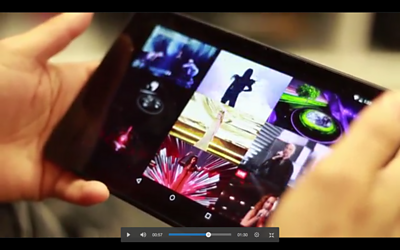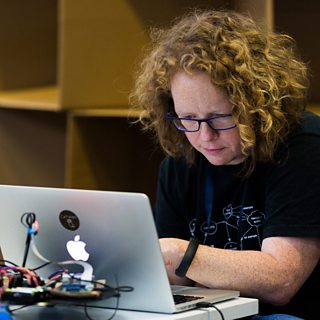
In this week's installment of the IRFS R&D section's weeknotes, we hear about developments in exploring TV storylines and characters based on data, a news prototype based on "Atoms" of content, video fingerprinting, speech to text, and short research projects on set top boxes and VR for music.
The Devices team has been doing a number of short pieces of work that may become larger projects later.
Joanne is working with the UX&D and BCS teams on some potential MSc project questions, a way to develop interesting research questions that we don't have time to look at.
Our digital trainee is creating a VR / HTML / Music visualiser technical prototype and testing it on various devices, to see if the technologies he wants to use are responsive enough to make an interesting application.
I'm mid-analysis of the markets, technologies and standards around set top boxes and TV, background research that will feed into the 2-Immerse project as well as potentially kicking off other areas of research.
We're also finishing up the last few months of the MediaScape project. Chris has been writing a report, Joanne's finished analysing the user test results of our "EuroMeme" prototype and put forward some recommendations for user interface changes. Chris Ambrose from Connected Studio has made us an absolutely charming video to show EuroMeme's features, so we'll be blogging about that shortly.
Meanwhile the Content team are in the middle of two projects, Atomised News and Story explorer. Atomised News is a collaboration with News Labs that's building up to a prototype for Newsbeat, so Chrissy spent this sprint investigating integration with their "Vivo" system, while Barbara met with an agency to plan our next round of formal user testing for the prototype.
The team are developing Story Explorer for a TV programme, having previously made the data-driven exploration of storylines and characters for the radio drama ±«Óătvfront. Andrew has finalised the wireframes for the minimal version as well as future scalable options. The team met up with James and Richard, our developers on ±«Óătvfront to discuss the build requirements. The team (with Edwina on board as content producer) decided on using the drama “Peaky Blinders” based on the facts it has strong Male / Female characters and overlapping storylines.
We also welcomed a new addition to the Content team - Lara Bostock. This sprint she's been learning about the atomised news project, and started making improvements to the CSS for the prototype. Part of this involved making the text responsive and testing these changes out on android devices of various sizes.
The Data team are also in the middle of two projects: the CODAM project, our video fingerprinting collaboration with the University of Surrey and Visual Atoms, and speech to text work based on the Open Source project Kaldi.
This sprint the CODAM team have been visiting the project partners over at the University of Surrey. Ben and Jana have continued with the project refactoring and feature analysis, measuring the effect of each feature's component on the system's accuracy and performance.
In our speech-to-text work, Tom has found a good way of generating artificial test data for his work on Speech / Music discrimination, using FFMPEG to automatically mix the audio so he can now test the algorithm on a wider variety of conditions. Matt has been testing Kaldi model builds on a new fast machine bought for the purpose. So far so good and the hardware is proving much faster than what we were using before. We are using to run it on the machine, which nicely sandboxes each project's dependencies with minimal overheads.
The Discovery team have been applying their skills in locating, filtering and classifying diverse information sources to a project with Radio and Music, as well as improving their techniques for automated text analysis.
Interesting links from Henry:
- Henry did a talk on super-fashionable Conversational UIs, and has collected together - his favourite was ""
- is a piece about the attention economy, Facebook, and the human decisions which go into its feed algorithms and how its users curate its content.
- - Amazon's datacenters, where they are in the US, how that geography came to be and why it overlaps with the US's surveillance apparatus
- (see also: )
and one from me:
